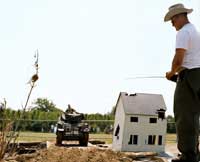 History will repeat itself. Strategies of Reenactment in Contemporary (Media) Art and Performance is probably the best exhibition i’ve seen this year. The show, which focuses on artistic strategies of re-enactment in contemporary (media) art and performance, has been set up by Hartware MedienKunstVerein, a platform for the production, presentation, education on and contextualisation of contemporary and experimental media art.
History will repeat itself. Strategies of Reenactment in Contemporary (Media) Art and Performance is probably the best exhibition i’ve seen this year. The show, which focuses on artistic strategies of re-enactment in contemporary (media) art and performance, has been set up by Hartware MedienKunstVerein, a platform for the production, presentation, education on and contextualisation of contemporary and experimental media art.
Gosh! was it good to be reminded that media art does not necessarily involve in-your-face interactive, flashy, entertaining installations (which i love except when they are nothing else than that.) This time, you have to sit down and engage with each work. Most of them are videos, usually not my favourite kind of media art but when the show is good, i sit down, shut up and enjoy. Not only is every single art work on display worth all your attention, but gathered in a single space they build up an intelligent and engrossing picture of what contemporary artistic re-enactments implies while providing you with many personal reflections about history, politics and society. There was way too many works for me to engage fully with so all i can do is look forward to see the exhibition again when it travels to Kunst-Werke in Berlin on 18 November 2007 – 13 January 2008.
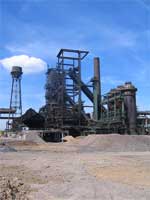
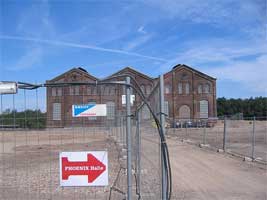 History Will Repeat Itself is located in the superb PHOENIX Halle Dortmund. Built in 1895, the three-aisle ex-factory is standing on the area of the former Phoenix-West steelworks in Dortmund-Hörde.
History Will Repeat Itself is located in the superb PHOENIX Halle Dortmund. Built in 1895, the three-aisle ex-factory is standing on the area of the former Phoenix-West steelworks in Dortmund-Hörde.
In general, a re-enactment is a historically correct recreation of socially relevant events, such as important battles or other historical events. In a re-enactment, the audience become immediate witnesses of a (repeated historical) event or they become participants in an action.
Unlike popular historical re-enactments, artistic re-enactments are not performative re-stagings of historic situations and events that occurred a long time ago; rather, events are re-enacted that are viewed as very important for the present. They question the present via repeating or re-enacting historical events that have left their traces in the collective memory, while at the same time pointing towards the fact that collective memory is essentially mediated memory.
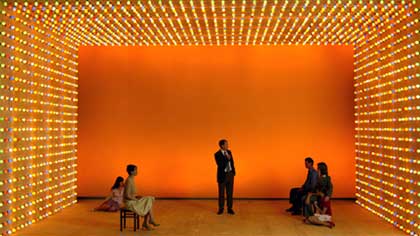
The most visible example of the power media has on memory is Unexpected Rules, by Frédéric Moser and Philippe Schwinger. On an empty stage, illuminated by coloured light bulbs, seven actors perform “The Clinton – Lewinsky Affair: from 1995 to 1996.
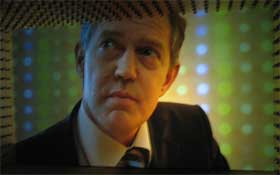 The affair, which was the HG of the media at the time,led to impeachment proceedings based on the report of the Republican investigator Kenneth Starr and a public apology of Clinton for lying.
The affair, which was the HG of the media at the time,led to impeachment proceedings based on the report of the Republican investigator Kenneth Starr and a public apology of Clinton for lying.
The re-enactment’s script begins with the spreading of an intrigue and ends with the whispering of a lie, both by the character of the lawyer. In between, the story unfolds between Amanda (Monica) and Roy (Clinton), the lawyer, the President’s family, and a secretary. Roy is shown as a victim of an intrigue out of political calculation, who only decides to perjure himself on the lawyer’s advice. The retelling of the event by the artists reveals the impossibility of arriving at a truthful analysis amidst the various interests surrounding the affair and their representation in the media.
Questions about the power of media to shape our memories and vision of an event get even more acute with Jeremy Deller’s The Battle of Orgreave.
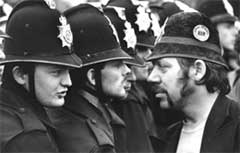 The movie recreates the violent clash between the Thatcher government and the British National Union of Mineworkers in 1984–1985, near the coking plant of Orgreave in South Yorkshire.
The movie recreates the violent clash between the Thatcher government and the British National Union of Mineworkers in 1984–1985, near the coking plant of Orgreave in South Yorkshire.
After three years of intense research, Deller recreated the “battle� in 2001 with the help of “re-enactment� groups, miners, and policemen who participated in the event
Because the reports in the media at the time were strongly influenced by the government, and the workers and trade unions were described as “the enemy within� (Margaret Thatcher), Deller did not use contemporary media reports. Instead, he used the memories of the protagonists – miners and policemen alike – as the basis of the re-enactment, correcting the (distorted) image projected by the media is corrected.
The re-enactment and the documentary, which film director Mike Figgis made for Channel 4 (he combines scenes of the re-enactment of 2001 with photographs of the clashes of 1984), generate a new and different practice of the historicisation of recent, still sensitive English history, which remains relevant today for existing political and social conflicts.
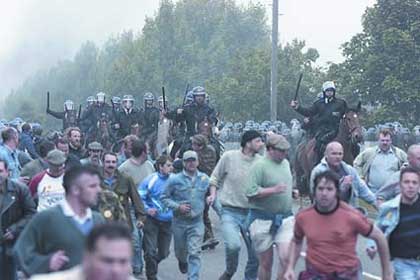
Two videos you might want to have a look at: 1 and 2.
The exhibition is on view until September 23, 2007 at the PHOENIX Halle Dortmund.
Photo credit: image on top left corner is from Heike Gallmeier’s series of photographies taken at the War & Peace Show; first image of Unexpected Rules (Fundación Bienal de Sao Paulo); B&W photo of Battle of Orgreave by Don McPhee (found in The Guardian) All my images.
Related: The Port Huron Project, a series of reenactments of protest speeches from the New Left movements of the 1960s and ’70s.
